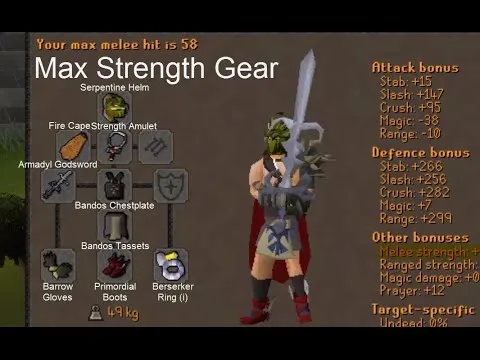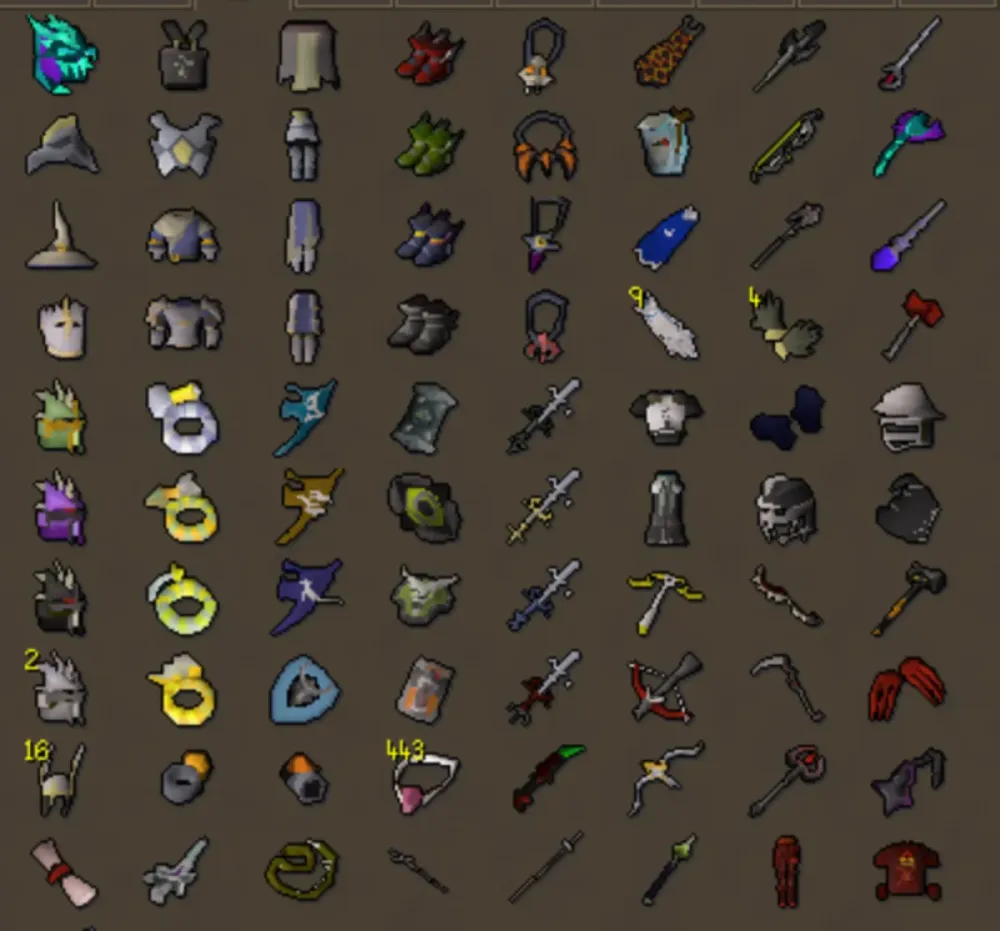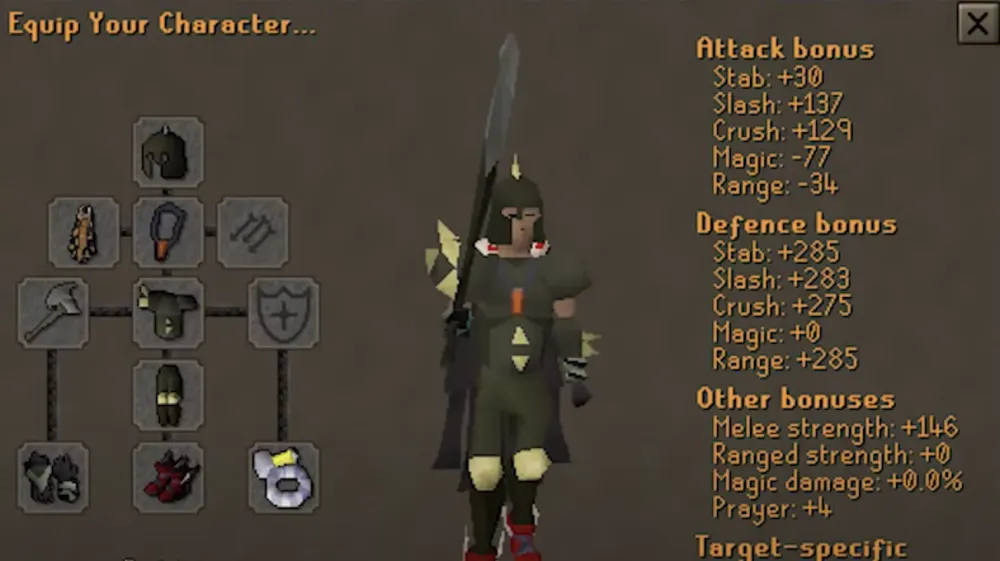Your cart is empty
Melee Gear Guide for Old School RuneScape (OSRS)

Melee gear in Old School RuneScape (OSRS) is crucial for players aiming to maximize their combat effectiveness in PvE and PvP scenarios. With a variety of weapons, armor sets, and accessories available, understanding the options can significantly enhance your gameplay experience. In this guide, we will explore the fundamentals of melee gear, including the different tiers and the stats that influence combat performance. Whether you are a beginner or a seasoned player, knowing how to choose the right gear can make a substantial difference in your adventures across Gielinor.
In OSRS, melee gear is categorized into different tiers based on its strength, defensive capabilities, and overall effectiveness. Each tier represents a level of power and is influenced by the player’s Attack and Defence levels. The tiers range from bronze and iron gear at the lower end to the powerful godswords and abyssal gear at the higher end. Understanding these tiers is essential for optimizing your combat style.
Weapons are classified by their attack styles, which include stab, slash, and crush. Each weapon type has strengths and weaknesses against different enemy defenses. For instance, scimitars are favored for their high slash damage and speed, making them ideal for training and boss fights. On the other hand, weapons like the whip offer a balance of speed and damage, making them versatile for various situations.
Armor sets are equally important as they provide critical defensive bonuses. The armor tier system starts with low-level sets such as bronze and iron, progressing to steel, mithril, adamant, and rune. Higher-tier armor not only offers better protection but also enhances specific combat stats like Strength and Defence. For example, the rune armor set is highly sought after for its impressive defensive bonuses, while the Bandos gear is favored for its Strength bonuses, making it excellent for melee combat.
Additionally, gear stats play a pivotal role in combat effectiveness. Key stats to consider include Attack, Strength, Defence, and Prayer. Attack determines your ability to hit opponents, while Strength influences the damage dealt. Defence reduces incoming damage, and Prayer can provide various benefits, such as damage reduction or healing. Balancing these stats based on your combat style and the enemies you face is essential for maximizing your performance.
In conclusion, understanding gear tiers and stats in OSRS is vital for any melee-focused player. By selecting the appropriate weapons and armor based on your combat level and the challenges ahead, you can significantly enhance your effectiveness in battles throughout Gielinor.
Essential Melee Weapons

When it comes to melee combat in Old School RuneScape (OSRS), having the right weapon can make all the difference. Here’s a rundown of some essential melee weapons that you should consider for your adventures:
- Whip: The Abyssal Whip is a fan favorite. With its fast attack speed and excellent strength bonus, it’s perfect for slaying monsters and training combat skills.
- Scimitar: Scimitars like the Rune Scimitar are great for their balance between speed and damage. They are ideal for training and PvP situations.
- Longsword: The Rune Longsword offers a good combination of speed and power, making it versatile for different combat scenarios.
- Great Axe: The Dragon Axe is a slow weapon but hits hard. Use it for training strength or when you need that extra damage.
- Claws: The Dragon Claws are known for their special attack, which can deal massive damage in one hit. Perfect for PvP encounters!
Choosing the right weapon will depend on your combat style and the level of the monsters you intend to fight. Experiment with different weapons to find the one that suits your playstyle best!
Best Armor Sets for Different Combat Levels

Armor is crucial in OSRS, not just for defense but also for enhancing your melee stats. Here’s a breakdown of the best armor sets for various combat levels:
| Combat Level | Armor Set | Key Benefits |
|---|---|---|
| 1-20 | Iron Armor Set | Good balance of defense; affordable and easy to obtain. |
| 20-40 | Steel Armor Set | Significantly better protection; helps in early PvP. |
| 40-70 | Rune Armor Set | High defense and strength bonuses; essential for mid-level bosses. |
| 70+ | Dragon Armor Set | Top-tier defense; excellent for endgame content; enhances damage. |
When choosing an armor set, consider your combat style and the enemies you will face. Always aim for a balance between defense and offensive capabilities to maximize your effectiveness in battle!
5. Accessories and Their Impact on Melee Combat
When it comes to maximizing your melee combat effectiveness in Old School RuneScape (OSRS), accessories play a crucial role. These items can significantly enhance your stats and offer unique benefits that can make a world of difference in both PvE and PvP scenarios.
Here are some key accessories you should consider:
- Amulets: Items like the Amulet of Fury or the Amulet of Torture boost your Attack and Strength stats, enhancing your melee damage output. The Amulet of Glory is also a solid choice for its teleportation capabilities.
- Rings: The Berserker Ring (imbued) is a favorite for its Strength bonus, while the Warrior Ring provides a nice Attack bonus. Don’t underestimate the power of the Ring of Wealth, which can help you earn more loot!
- Capes: The Fire Cape and the Ardougne Cloak are both excellent choices. The Fire Cape provides a solid bonus to your Attack and Strength, while the Ardougne Cloak comes with useful teleports and other perks.
- Boots: Boots of Lightness are essential for agility training, but for melee combat, you want to opt for items like the Bandos Boots, which provide a significant Strength bonus.
Using the right accessories can mean the difference between a quick kill and a lengthy battle. Pay attention to the bonuses each accessory provides, and tailor your setup to your specific combat goals.
6. Optimizing Your Melee Gear Setup for PvE
When gearing up for PvE (Player vs. Environment) content in OSRS, it’s essential to optimize your melee setup to ensure you can tackle bosses, quests, and slayer tasks effectively. A well-thought-out gear setup can enhance your performance and make your combat experience smoother.
Here’s a breakdown of how to optimize your melee gear for PvE:
| Slot | Recommended Gear | Notes |
|---|---|---|
| Head | Nezzy Helm / Helm of Neitiznot | Great for high defense and Strength bonuses. |
| Body | Bandos Chestplate | High defense and Strength bonus, ideal for tanking. |
| Legs | Bandos Tassets | Complements the Bandos set for added Strength. |
| Weapon | Scythe of Vitur / Abyssal Whip | Choose based on the situation; the Scythe is great for multi-target. |
| Shield | Dragon Defender | Offers a great balance of attack and defense. |
| Accessories | Amulet of Torture / Berserker Ring | Boosts your damage significantly. |
In addition to choosing the right gear, remember to consider your combat style. For PvE, it’s often beneficial to focus on maximizing your damage per second (DPS). This can involve using potions like Super Strength or Saradomin Brews for healing, alongside Prayer potions or food items to maintain your health during longer fights.
Lastly, don’t forget about your inventory setup. Always have a mix of supplies, including potions and food, to ensure you can sustain your combat effectiveness throughout your PvE encounters.
7. Tips for PvP Melee Gear Strategies
PvP combat in Old School RuneScape (OSRS) can be intense, and having the right melee gear strategy can make all the difference between victory and defeat. Here are some effective tips to enhance your melee combat experience in PvP:
- Know Your Opponent: Understanding the strengths and weaknesses of your opponent’s gear is crucial. If they are wearing heavy armor, consider using weapons with high accuracy to bypass their defense.
- Switch Gear Wisely: Be ready to switch between offensive and defensive gear. For example, if you notice your opponent has a low health pool, switch to your best damage-dealing gear to finish them off.
- Utilize Potions: Don’t forget about potions! Strength and attack potions can significantly increase your damage output. Make sure to carry them and use them strategically during fights.
- Use the Right Weapon: Different weapons have different attack speeds and styles. For instance, using a scimitar for faster hits or a long sword for higher damage can change the tide of battle.
- Incorporate Prayers: Using prayers like Protect from Melee or Smite can provide significant advantages in PvP. Always be aware of when to activate them to maximize their benefits.
- Practice Anti-Drag: Mastering the art of anti-dragonfire is essential when facing opponents with dragon weapons. Move strategically to avoid being hit while attacking.
Remember, practice makes perfect! Regularly engage in PvP combat to refine your skills and adapt your strategies based on your experiences.
8. How to Upgrade Your Melee Gear Efficiently
Upgrading your melee gear in OSRS can feel overwhelming, especially with so many options available. But with a bit of planning, you can do it efficiently! Here are some steps to consider:
- Prioritize Your Goals: Determine what you want to achieve. Are you aiming for PvP, PvE, or boss fights? Your objectives will dictate the type of gear you should focus on.
- Research Gear Tiers: Familiarize yourself with the different tiers of gear. For instance, start with Rune gear, and then aim for Dragon gear, followed by Barrows equipment.
- Gather Resources: Collect gold and necessary items before upgrading. Use methods like skilling, bossing, or merchanting to accumulate the wealth you need.
- Utilize the Grand Exchange: The Grand Exchange is a fantastic place to buy and sell gear. Keep an eye on market trends to find the best deals.
- Participate in Events: Engage in in-game events or activities that may provide gear upgrades or unique items. These can often be more accessible than grinding for resources.
- Trade with Other Players: Don’t hesitate to trade with other players for better gear. Networking in the OSRS community can lead to beneficial deals.
By following these steps and remaining patient, you can efficiently upgrade your melee gear and take your combat skills to the next level!
Melee Gear Guide for Old School RuneScape (OSRS)
Choosing the right melee gear in Old School RuneScape (OSRS) is crucial for maximizing your combat effectiveness. This guide outlines the best gear options available for various combat levels and scenarios.
1. Basic Gear (Levels 1-20)
For new players, focusing on affordable and accessible gear is key. Here are some recommended items:
- Weapon: Bronze Scimitar or Iron Scimitar
- Helmet: Iron Full Helm
- Body: Iron Platebody
- Legs: Iron Platelegs
- Shield: Iron kiteshield
2. Intermediate Gear (Levels 20-60)
As you progress, upgrading your gear becomes important. Consider the following:
- Weapon: Steel Scimitar or Adamant Scimitar
- Helmet: Mithril Full Helm
- Body: Mithril Platebody
- Legs: Mithril Platelegs
- Shield: Mithril kiteshield
3. Advanced Gear (Levels 60+)
For high-level players, top-tier gear is essential for maximizing damage output:
- Weapon: Godswords or Abyssal Whip
- Helmet: Neitiznot Faceguard
- Body: Bandos Chestplate
- Legs: Bandos Tassets
- Shield: Dragon Defender
4. Special Considerations
When selecting melee gear, consider the following factors:
| Factor | Details |
|---|---|
| Strength Bonus | Look for items that provide a high strength bonus to increase damage output. |
| Defensive Stats | Balance offense with solid defensive stats to survive tougher encounters. |
| Cost | Some high-tier gear can be costly; prioritize your spending based on your activities. |
Conclusion: Choosing the right gear for your playstyle involves balancing offense and defense while considering your level and budget. Tailor your gear choices to your specific combat goals for optimal performance.
